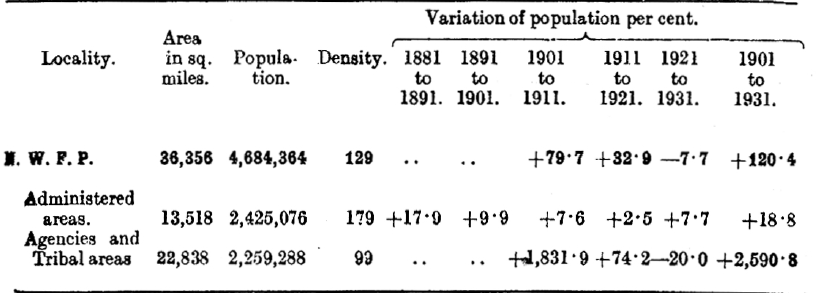Census India 1931: The Population Problem in Punjab
This article is an extract from CENSUS OF INDIA, 1931 Report by J. H. HUTTON, C.I.E., D.Sc., F.A.S.B., Corresponding Member of the Anthropologische Gesselschaft of Vienna. Delhi: Manager of Publications 1933 (Hutton was the Census Commissioner for India) Indpaedia is an archive. It neither agrees nor disagrees |
The Population Problem in North-West Frontier Province
The North-West Frontier Province has an area of 36,356 square North-West miles with a population of 4,684,364 and a mean density of 129 per square Frontier Province. mile, but of this area 22,838 square miles constitute the Trans-frontier Agencies, of the population of which 2,212,837 is only estimated and not obtained by enumeration, making a total with those enumerated in trans-frontier posts of 2,259,288 (density 99) and leaving 2,425,076 persons in the five regularly administered districts with an area of 13,518 square miles and a mean density of 179, an area a little greater than that of Holland with a population a little less than that of Denmark.
Since 1921 the Malandri tract, 20 square miles, has been added to the administered from the unadministered area and 4 square miles have been transferred from Kohat District to the former. Otherwise there has been IA)territorial change.
The density of population in the administered areas exclusive of urban population varies according to the combined factor of rainfall x irrigable land, decreasing from north to south.
The growth of population has depended mainly on the extension of canal irrigation. The Kabul River Canal reached its maximum area of irrigation in 1921 and the Upper Swat Canal in 1929. When the decade opened the agricultural position was bad and the frontier was disturbed, a condition which, however, benefits the inhabitants of the administered districts financially. Both contractors and unskilled labour do well and " to the Pathan of fighting age times of unrest call up memories of a princely pay earned in princery idleness, guarding with a government rifle and the prestige of his race some lonely spot on a winding frontier road ".
The situation on the frontier improved rapidly, but this improvement was followed by outbreaks of internal disturbance in 1924 and 1927 of a communal nature and in 1929 by revolutionary outbreaks all over the province culminating in the very serious riots of April 1930 in Peshawar with inevitable repercussions among the border tribes, though the situation was restored in time for the census to be taken generally under normal conditions.
Agriculturally the decade was satisfactory until 1924, less satisfactory from 1924 to 1928 but improved from 1928 to 1930 when a deficient fall of rain and an excessive fall in prices combined to reduce greatly the area sown for crops. Rs. 22,06,956 of revenue were remitted on account of damage by locusts in the years 1929-30. Public health was bad in the first half of the decade, which the Census Superintendent attributes to the after effects of the influenza epidemic, but the second half was one of " uninterrupted good health " which " restored to the people their normal vitality ", and the increase of population in the administered districts since 1921 has been 7.7%.
The Co-operative Credit movement was started in 1925, and in 1926 there were 16 societies with a membership of 365 and a working capital of Rs. 39,317. In 1930 there were 166 societies with 5,825 members and a working capital of Rs. 8,92,000. The primary necessity of the province is a settled economic outlook without which an increase in population disproportionate to that in wealth and productive efficiency will involve poverty and discontent and in all probability a destructive agitation and very serious disturbance.
